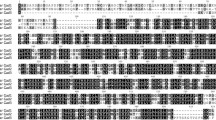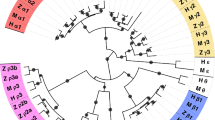Abstract
The AMPA receptor (AMPAR), a pharmacologically defined ionotropic glutamate receptor, mediates fast excitatory synaptic transmission in the vertebrate central nervous system. Mammalian and avian AMPARs are assembled from the products of four genes (GRIA1–GRIA4) conserved in their translated sequences and gene organizations. Teleost fish also express AMPAR subunits; however, the AMPAR genes have not been extensively investigated in lower vertebrates. To elucidate the evolution of vertebrate AMPAR genes, reverse-transcriptase PCR-based surveys of subunits expressed in the brains of eight nonmammalian vertebrates were performed. The newly cloned vertebrate AMPAR subunits were classified by their sequence identities to the mammalian AMPAR subunits. The results of molecular and phylogenetic analyses indicated that the members of the AMPAR gene family increased from two in the jawless hagfish to four in the tetrapods and the shark and to more than four in the teleost fish. The sizes of AMPAR gene families correlate well with those of many multigene families observed in various vertebrates. Moreover, all vertebrates expressed at least one AMPAR subunit bearing an arginine (R) at the Q/R site, at which no invertebrate glutamate receptor subunit has been found to have an R residue, suggesting that the low calcium-permeable AMPARs appeared at early evolutionary stages of vertebrate central nervous systems. Uniquely, the loop 1 (L1) regions between hydrophobic domain 1 and hydrophobic domain 2 of the hagfish putative GRIA2 and all the teleost GRIA1 subunits were much longer than those of the remaining known ionotropic glutamate receptor subunits. The length and sequence of the L1 of teleost GRIA1 subunits were heterogeneous, suggesting that the amino acid residues in L1 were not highly selected.
Similar content being viewed by others
Author information
Authors and Affiliations
Additional information
Received: 24 November 2001 / Accepted: 9 May 2001
Rights and permissions
About this article
Cite this article
Chen, YC., Kung, SS., Chen, BY. et al. Identifications, Classification, and Evolution of the Vertebrate α-Amino-3-Hydroxy-5-Methyl-4-Isoxazole Propionic Acid (AMPA) Receptor Subunit Genes. J Mol Evol 53, 690–702 (2001). https://doi.org/10.1007/s002390010256
Published:
Issue Date:
DOI: https://doi.org/10.1007/s002390010256




